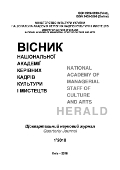ІМПРЕСІОНІСТСЬКО-СИМВОЛІСТСЬКІ СКЛАДОВІ СТИЛЬОВОГО НАПОВНЕННЯ ТВОРЧОСТІ В. БАРВІНСЬКОГО (НА ПРИКЛАДІ СОНАТИ DES-DUR) І М. КОЛЕССИ (НА ПРИКЛАДІ СОНАТИНИ)
DOI:
https://doi.org/10.32461/2226-3209.1.2018.160512Ключові слова:
імпресіонізм, символізм, романтизм, стиль у музиці, неокласицизм, музичний жанрАнотація
Мета роботи. Стаття присвячена виявленню стильових ознак імпресіонізму й символізму в творчості Василя Барвінського й Миколи Колесси. Методологія дослідження визначена інтонаційним підходом у руслі школи Б. Асафьєва в Україні. Використовуються методи стильового компаративу й музичної герменевтики, що дає змогу виявити в музикознавчому аналізі стильові зрізи, не відзначені раніше в характеристиці творчості зазначених авторів. Наукова новизна дослідження пов'язана з тим, що вперше в музикознавстві України виявлені у фортепіанних композиціях митців ознаки зв'язку з музичним модерном у вигляді використання засобів і виразних компонентів імпресіонізму й символізму. Висновки. Аналіз Сонати Барвінського і Сонатини Колесси показо-вий у виявленні вказаних стильових складових. В межах постмодернізму, стильові тяжіння якого мають неосимволістську спрямованість, вказані апеляції до імпресіонізму-символізму актуалізуються у слуховому сприйнятті композицій західноукраїнських майстрів, заохочуючи відповідні репертуарні вибори виконавців.
Посилання
Гегель Г. "Дух свого времени" Der Geistseines Zeit. Інтернетресурс: "Дух свого времени" Der Geist-seines Zeit. https: // ru.wikipedia.org / wiki / Дух_времени
Горюхіна Н. Еволюція сонатної форми. / Н. Горюхіна. – К. : "Музична Україна", 1973. – 310 с.
Кальмучин-Дранчук Т. Фортепіанна творчість М. Колесси в контексті проблеми виконавської інтерпретації / Т. Кальмучин-Дранчук // Вісник Прикарпатського університету. Мистецтвознавство. –2005. – Вип. VІІІ. – С. 73-80.
Кассу Ж. Энциклопедия символизма: Живопись, графика и скульптура. Литература. Музыка / Ж. Кассу, П. Брюнель, Ф. Клодон и др.; науч.ред и авт.послесл. В.М. Толмачев; пер. с фр. – Москва: Республика, 1999. – 412 с.
Кияновська Л. Стильова еволюція галицької музичної культури ХІХ – ХХ ст. / Л. Кияновська. –
Тернопіль: Астон, 2000. – 339 с.
Кияновська Л. Син століття – Микола Колесса / Л. Кияновська – Львів: ЛДМА ім. М. В. Лисенка., вид-
во НТШ, 2003. – 294 с.
Маркова Е. Проблемы музыкальной культурологии / Е. Маркова. – Одесса: Астропринт, 2012. – 164 с.
Муляр П. Стиль твору і виконавської інтерпретації в аспекті класичного та акласичного у фортепіанному мистецтві: автореф. канд. дис. / П. Муляр. – Одеса, ОНМА ім. А.В. Нежданової, 2009. – 17 с.
Хіль О.М. Тема дитинства-юнацтва як фактор жанрової типології фортепіанного концерту в вітчизняній інструментальній музиці XX століття : дис. кандидата мистецтвознавства / Хіль Олена Михайлівна. – Одеса: ОНМА ім. А.В. Нежданової, 2015. – 155 с.
Hehel H."The Spirit of Your Time" Der Geistseines Zeit. Internet resource: "The spirit of your time" Der Geistseines Zeit. Retrieved from // ru.wikipedia.org / wiki / Spiritoftheday
Horyukhina N. (1973). Evolution of the sonata form. Kyiv: "Muzychna Ukrayina" [in Ukrainian].
Kalmuchyn- Dranchuk, T. (2005). M. Kolessa’s pianoforte work in the context of performance explication problem. Bulletin of the Precarpathian University. Art studies, Vol. VІІІ, 73-80 [in Ukrainian].
Jean Cassou. (1999). Encyclopedia of Symbolism: Painting, Graphics and Sculpture. Lyteratura. Muzyka / Jean Cassou, Pierre Brunel, Francis Claudon. etal.; nauch.redetavt.poslesl. VM Tolmachev; per.sfr. – Moscov: Répub-lique.- 412 c, fig [in Russian].
Kyyanovska, L. (2000). Style evolution of Galician musical culture of the 19th – 20th centuries. Ternopil: As-ton [in Ukrainian].
Kyyanovska, L. (2003). Son of the century – Mykola Kolessa. Lviv: Lviv National Musical Academy named after. M. Lysenko., View of NTSh [in Ukrainian].
Markova, E. (2012). Problems of musical culturology. Odessa: Astroprint [in Ukrainian].
Muliar, P. (2009). The style of the work and performing interpretation in the aspect of classical and aclassical in piano art. Extended abstract of candidate`s thesis. Odessa: ONMA named after A.V. Nezhdanova [in Ukrainian].
Khil, O.M. (2015). The theme of childhood, youth as a genre factor of typology of pianoforte concert in do-mestic instrumental music of the 20th century: dis. PHD. Odesa: ONMA named after A.V. Nezhdanova [in Ukrainian].
##submission.downloads##
Опубліковано
Номер
Розділ
Ліцензія
Автори, які публікуються у цьому журналі, погоджуються з наступними умовами:
1. Автори залишають за собою право на авторство своєї роботи та передають журналу право першої публікації цієї роботи на умовах ліцензії Creative Commons Attribution License International CC-BY, котра дозволяє іншим особам вільно розповсюджувати опубліковану роботу з обов'язковим посиланням на авторів оригінальної роботи та першу публікацію роботи у цьому журналі.
2. Автори мають право укладати самостійні додаткові угоди щодо неексклюзивного розповсюдження роботи у тому вигляді, в якому вона була опублікована цим журналом (наприклад, розміщувати роботу в електронному сховищі установи або публікувати у складі монографії), за умови збереження посилання на першу публікацію роботи у цьому журналі.
3.Політика журналу дозволяє і заохочує розміщення авторами в мережі Інтернет (наприклад, у сховищах установ або на особистих веб-сайтах) рукопису роботи, як до подання цього рукопису до редакції, так і під час його редакційного опрацювання, оскільки це сприяє виникненню продуктивної наукової дискусії та позитивно позначається на оперативності та динаміці цитування опублікованої роботи.

